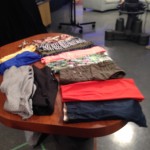We are mid-way through September! Kids are in school, activities are starting and routines are kicking into gear. Seems like a good time to remind you about the Fall Fast Fashion Challenge! There is growing awareness about “Fast Fashion.” Some people truly don’t know what that term refers to – if you don’t know, please read all about the challenge to NOT buy fast fashion because I include several informative links in my post. And then, once you know, YOU KNOW. We cannot pretend that the global garment industry isn’t horrifying. We cannot pretend that there aren’t viable alternatives to fast fashion that only require a simple decision to do something different! There are many brands that manufacture in North America, many local designers or hand-made products available locally, at markets or on Etsy, many on-line ethical and sustainable shopping options, and if all else fails, I for one (in case you haven’t noticed) advocate thrifting as the cheapest easiest antidote to fast fashion!
As I was preparing for my challenge, I had a good (email) conversation with Nadine Riopel, formerly of The Savvy Do Gooder, now known as Nadine Riopel. 🙂 As usual, Nadine did all the insightful loquacious super-smarty-pants talking, and I sipped wine and nodded approvingly. Nadine’s insight is too important not to share, so I’m sharing now to give everyone a little food for thought this weekend, a little reason NOT to shop at H&M or Joe Fresh or Walmart or Old Navy or Banana Republic. Read this, refer to my Fast Fashion Challenge, and please please take a step towards slow fashion.

Nadine, I know you’re super smart and eloquent. Help me out here. I was chatting with someone who had a friend that was teaching in Bangladesh and apparently this friend said that we should be buying “fast fashion” labels because without that, the locals won’t have a job. What say you?

Oh Nicole! You are ALSO super-smart and eloquent especially with a few glasses of wine to loose the tongue. And might I mention, that I LOVE multiple necklaces!! xoxoxox (That part is total fiction.) I have heard the argument made that garment sweat shops are somehow a natural and unavoidable part of the global economy and places like Bangladesh just have to suck it up and endure a period of time where that’s part of their economy. The idea is that it’s a step on the road to a more robust and sophisticated industry, that eventually they will evolve into something that provides better jobs and the sweat shop stuff will somehow shift to a less evolved location.

That’s exactly what I said. (total fiction)

I realize your friend isn’t really talking about that economic theory. If I understand you right, she’s just suggesting that if not for the dangerous and exploitative garment industry jobs, people in Bangladesh would have no jobs at all.

Mmmmhmmmm. (my sum total contribution to this conversation from here on out)

Either way, I don’t buy it, although I’ll admit I’m no economist.

Surprise! I am!!
Jk.

Are we really saying that churning through resources in a way that treats the human inputs like trash is unavoidable? First off, ill-treatment of workers is not the only issue with fast fashion. Fabric production is notoriously resource intensive and polluting. And all that discarded cheap clothing goes somewhere when we’re done with it – landfills and God only knows where else where it will sit, decomposing naturally if we’re lucky, and failing to decompose and leaching chemicals into the earth, air, and water if we’re not.

*Shudder*

And let’s not forget the fallout of rampant consumerism in the places where fast fashion is being purchased. The culture of ‘never enough’ and ‘more is always better, new is always better’ that fast fashion is so much a part of is wreaking havoc every day. Hoarding, depression, image obsession, stress related ailments, huge consumer debt: it’s all connected and it’s hurting us immensely. So even if fast fashion were a job creation life saver for poor countries, I’m not sure it would be justifiable.

Agreed.

And let’s look at that job creation issue for a moment. It’s true that the issue is complex. Swooping in as westerners and making changes in places we perceive as needing our help has pretty consistently been shown to have disastrous results. And certainly, people need to be able to earn a livelihood. But when we are a big part of the cause of the conditions we see as unacceptable, I believe that gives us a little more of a leg to stand on in making changes. To stop being the cause of the problems seems like the least we can do.

Stop causing problems then acting like we’re heroes when we go in and “fix” them. Got it.

Is your friend assuming that if sweat shops pulled out of Bangladesh, the people who live there wouldn’t be able to come up with any other way to make a living? Or migrate to somewhere they could? If so, why not? Industries have been rising and falling throughout history. People adapt. If you think they can’t, is it because of some other horrible condition that is also somehow our fault (for example: big North American corporations making it illegal for them to save seeds and grow food)? If so, the right thing to do is to work against the condition through your involvement in it, just as you did with fast fashion.

Boo yah. (Do people say that anymore?)

If not, are we basically saying these people are helpless victims, unable to find their own solutions, without resources, without agency, even in spite of the many and well-funded international agencies on the ground trying to help them? They’re simple-minded weak “children” who can’t do anything for themselves? This is the logical but uncomfortable underlying assumption of many international aid efforts and it’s a big part of why they waste so much money. It’s well-intentioned but very problematic. I could write a whole essay on that but I’ll refrain for now.

I would totally read that. I said to my friend that The True Cost movie includes discussion that the cost of garments should be higher so that consumers are “paying the cost” of manufacturing, not the workers. She then said that even if the price were raised, the money wouldn’t end up benefiting the workers…. probably true.

Indeed, probably true, if all you do is pay more. But I bet there are certification programmes for ethical and sustainable clothing production, and I know for sure there are stores that specialise in it. Paying more and hoping it trickles down is foolish, yes. But paying more to a provider you are fairly confident is translating your extra dollars into better production methods is not. It might take a little research to figure out which stores and/or brands and/or certifications you can trust, but it seems like the best and most logical way to keep generating employment for garment workers without just throwing up your hands and accepting fast fashion.

That’s what I wish I would have said.

How does all this play into thrifting? I see thrifting as a way to get more mileage out of the resources we do put into fast fashion and hopefully decrease the demand for it. Also, delay the speed with which discarded clothes end up in landfill or dumped on poorer markets. If everyone did it, I guess we’d put the fast fashion industry out of business, eventually run through the backlog of garments out there, and have to reinvent how we get our clothes. Who knows how that would go? But thrifting puts a spoke in the wheel of this massive fast fashion machine that’s just chewing up resources and people and spitting out clothes, and that’s got to be a good thing.

My sentiments exactly!! Thrifting is always a good idea, especially as an intentional, affordable action against fast fashion! At the very least, rather than throwing out old clothes, people can donate to local thrift shops on site or at one of the Donation Drop Spots, like the seven Value Village just opened up in and around Edmonton – I’ll share more about those later this weekend.

You have excellent instincts about thrifting, just like you do about layering necklaces. (exercising my creative license with this last part)

Nadine, thank you so much for taking the time to respond to my questions with such insight! Thank you for being such a supporter of thrift shopping in Edmonton, and for helping our community do real good! YOU are making a difference!




4 Comments
Nadine Riopel Professional Services thanks for your time and the insightful discussion! You rock.
Oh. My. Gosh. Such a wonderful read and so thought provoking and yet SO funny. Boo Yah! U0001f44f
Nicole Ebbesen Rowan, you’re hilarious. Thanks for doing this. And who knew you had so many pictures of me?!!
“Stop causing problems then acting like we’re heroes when we go in and ‘fix’ them” – SO TRUE. Reducing the negative impacts of the garment industry is a responsibility, not a gift.
Thanks for the well-thought-out discussion!